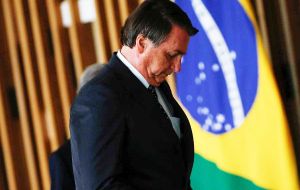MercoPress. South Atlantic News Agency
Bolsonaro “transformative” reforms' goal for Brazil, with a 3,5% average growth during a decade
 Brazil's GDP per capita in U.S. dollars would be above that of other emerging nations such as Argentina, Poland and Croatia by 2031, and closer to Chile
Brazil's GDP per capita in U.S. dollars would be above that of other emerging nations such as Argentina, Poland and Croatia by 2031, and closer to Chile  According to the strategy plan, signed president Jair Bolsonaro, the base case is for an accumulated rise in GDP per capita of 19.1% over the next decade
According to the strategy plan, signed president Jair Bolsonaro, the base case is for an accumulated rise in GDP per capita of 19.1% over the next decade Brazil's government on Tuesday outlined a long-term roadmap for the economy, based on three scenarios of economic and fiscal reforms that could lift gross domestic product per capita by as much as 37% over the next decade.
According to the “Federal Development Strategy” in the Official Gazette, that is the upper end of the scale resulting from a series of “transformative” reforms and educational advances over 2021-2031 that would deliver average annual GDP growth of 3.5%.
This would lift Brazil's GDP per capita in U.S. dollars above that of other emerging nations such as Argentina, Poland and Croatia by 2031, and closer to Chile and Hungary, countries ranked highly in the Human Development Index.
Brazil will go into next year with a record debt and deficit around 95% and 12% of GDP, respectively, due to huge emergency expenditure this year to tackle the COVID-19 pandemic.
“Macroeconomic stability, continuing the long-term fiscal adjustment agenda and monetary policy balance, are necessary conditions for a return to sustained growth,” the government said in the decree.
According to the strategy plan, signed off by President Jair Bolsonaro and Economy Minister Paulo Guedes, the base case is for an accumulated rise in GDP per capita of 19.1% over the next decade, on annual average GDP growth of 2.2%.
After the financial damage wrought by COVID-19, “If the necessary reforms are not implemented, the likelihood of a fiscal crisis and economic growth crisis in the coming years will increase significantly,” the plan said.
The third and most bearish scenario of no fiscal adjustment or market-friendly reforms would crash the economy and public finances. “For obvious reasons, it serves no purpose to include forecasts in this scenario,” the plan said.




Top Comments
Disclaimer & comment rulesCommenting for this story is now closed.
If you have a Facebook account, become a fan and comment on our Facebook Page!